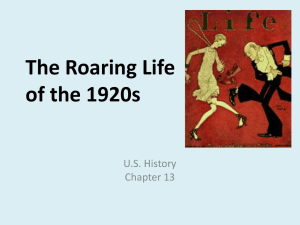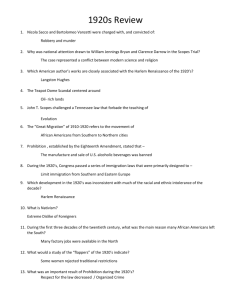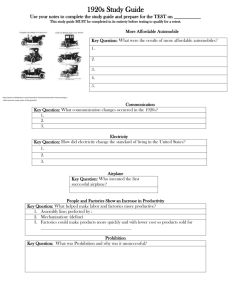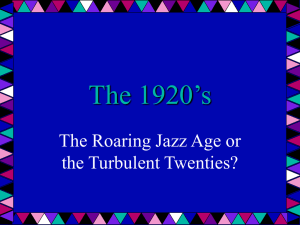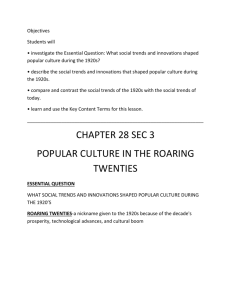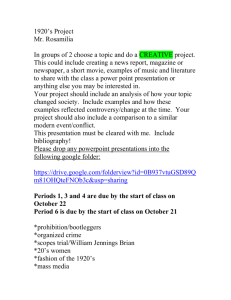Chapter 13 - Class Notes - Germantown School District
advertisement
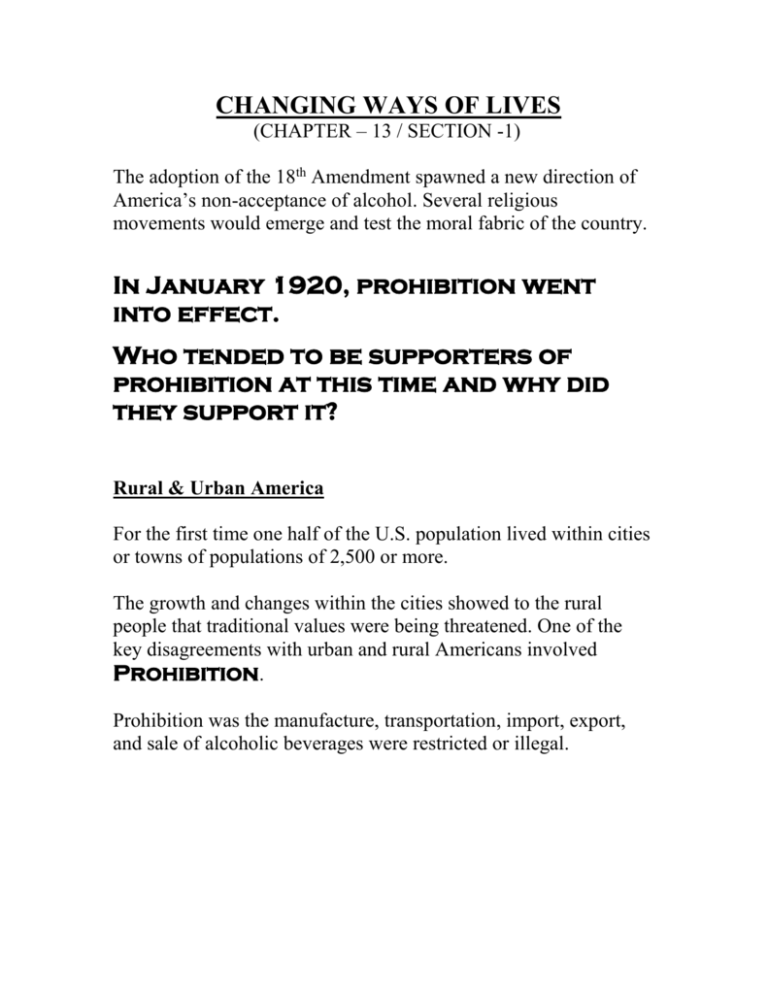
CHANGING WAYS OF LIVES (CHAPTER – 13 / SECTION -1) The adoption of the 18th Amendment spawned a new direction of America’s non-acceptance of alcohol. Several religious movements would emerge and test the moral fabric of the country. In January 1920, prohibition went into effect. Who tended to be supporters of prohibition at this time and why did they support it? Rural & Urban America For the first time one half of the U.S. population lived within cities or towns of populations of 2,500 or more. The growth and changes within the cities showed to the rural people that traditional values were being threatened. One of the key disagreements with urban and rural Americans involved Prohibition. Prohibition was the manufacture, transportation, import, export, and sale of alcoholic beverages were restricted or illegal. Supporters of Prohibition Largely from the South and West In large populations of native-born Protestants Members of the Anti-Saloon League and Women’s Christian Temperance Union Reasons for Supporting Prohibition Liquor a prime cause of corruption Too much drinking led to crime, wife and child abuse, accidents on the job and other social problems One of the reasons for the change toward breweries was due to that so many were owned and operated by German Americans. In doing so, it defined the term "beer, wine, or other intoxicating malt liquors to mean any beverage with greater than 0.5% alcohol by volume. Who tended to be opponents of prohibition at this time? Why did they oppose it? Opponents to Prohibition Were many liberals, conservatives, and intellectuals; immigrant groups; people who opposed the government’s meddling in their lives. People were tired of making sacrifices and wanted to enjoy life and didn’t consider drinking sinful or unhealthy, The people also resented the government’s meddling in their lives. Drinkers go underground to nightclubs known as Speakeasies, because once inside the club one should speak quietly or easily to avoid detection from the law. Speakeasies gained their name from the fact that a patron had to "speak easy" and convince the doorman to let them in. His job was to keep out those who looked like they were "dry" agents. Agents had no forced-entry rights at all, and so could not break into an establishment if the doorman refused them entry. For every legitimate saloon that closed as a result of the new law, half dozen underground palaces sprung up. By the middle of the decade there were thought to be 100,000 speakeasies in New York City alone. People build their own stills. Alcohol was also still allowed for medicinal and religious purposes People who sought liquor went to Bootleggers, smuggler’s that used boots to hide any alcohol During Prohibition much of the bootleg whiskey was brought in from Canada and much of the bootleg rum was imported from Mexico or Cuba via "rum roads" or "rum routes." Some people would steal alcohol intended for legal products, such as perfumes and antifreeze. Organized Crime grew within the age of Prohibition. Al Capone, Chicago’s organized boss leader, made $60 million a year and would kill off any of his competitors Why was prohibition repealed? Prohibition is Repealed Government fails to fund enough money to enforce the law Problem of patrolling 18,700 miles of boarders and coastlines Tracking down illegal stills, monitoring highways of trucks By the mid-1920’s only 19% of the US supported Prohibition The 18th amendment was eventually repealed with the 21st Amendment in 1933. This is the only Amendment ever to be repealed. Fundamentalism Fundamentalism has come to refer to several different understandings of religious thought and practice, through literal interpretation of religious texts such as the Bible. People began to question the technology growth within the country. Were these new scientific advances contributing to our prosperity or are they undermining our morals. Aimee McPherson emphasized the blessings and personal joy brought by faith. She built a temple in Los Angeles and broadcast to millions across the nation. The Scopes Trial Many criticisms of the fundamentalist position are that the theological claims made by fundamentalist groups cannot be proven, are irrational or are demonstrably false and contrary to scientific evidence. On March 13, 1925, Tennessee forbade the teaching, in any statefunded educational establishment of "any theory that denies the story of the Divine Creation of man as taught in the Bible, and to teach instead that man has descended from a lower order of animals." This is often interpreted as meaning that the law forbade the teaching of any aspect of the theory of evolution. Some of these criticisms were famously asserted by Clarence Darrow in the Scopes Monkey Trial. He stated that he would defend any school teacher that would challenge the law. John T Scopes, a biology teacher from Dayton TN, accepted the challenge and taught read from the class text claiming that life sprung from a one-celled forms and culminated into man. ______________________________________________________ At issue was the Butler Act, which had been passed a few months earlier by the Tennessee Assembly. The Butler Act provided: "... that it shall be unlawful for any teacher in any of the Universities, Normal and all other public schools of the State which are supported in whole or in part by the public school funds of the State, to teach any theory that denies the story of the Divine Creation of man as taught in the Bible, and to teach instead that man has descended from a lower order of animals." In July 1925, Clarence Darrow and William Jennings Bryan faced each other in the Scopes trial Who were Darrow’s main supporters? Why did they support him? Darrow’s Supporters His supporters were the people that supported the theory of evolution and challenged the Fundamentalist beliefs. Secular (not connected with church or religion) thinkers, Moderate Protestants and the American Civil Liberties Union, People who didn’t interpret the Bible literally and people who believed in Darwin’s theory of evolution ______________________________________________________ Why did they support his cause? Supported by scientific thinking people, People that believed in Darwin’s theory of evolution; did not believe the Bible should be interpreted literally, People that were concerned about the growing political power of fundamentalists Who were Bryan’s main supporters? Why did they support him? Bryan’s Supporters His supporters can from the Fundamentalists that believed in the words and teachings that existed in the bible. Protestant fundamentalists that believed in creationism and the literal interpretation of Genesis People that were skeptical of scientific knowledge and did not want evolution taught to their children Why did they support his cause? They believed in creationism, the literal interpretation of Genesis; They were skeptical of scientific knowledge and did not want evolution taught to their children What was the outcome of the case? ________________________________________________ Trial Outcome At that time in history the theory of evolution was considered controversial in public opinion, and a large fraction of its detractors linked it with atheism. However, John Scopes, a Tennessee high school science teacher, was convicted and fined $100. The Tennessee Supreme court later over turned the conviction in 1927 on a technicality. THE TWENTIES WOMEN (CHAPTER – 13 / SECTION -2) Social Life of the 1920’s During WWI the work place found women filling roles of missing men. However, when the war ended business and union leaders asked women to give up their jobs for returning veterans. Many women did not want to give up the independence and worked as secretaries, nursing and teachers. Women began to assert their independence and reject the values of the 19th Century claiming a desire to have the same freedoms that men possessed. Note two ways women’s fashions changed The Flapper A new ideal emerged within the fashion world in which women could embrace the emancipation of themselves within the use of fashion. This new fashion look was known as the Flapper, Brighter colors and shorter and looser-fitting dresses Stockings skin-toned instead of black and pumps instead of high-laced shoes Hair boyishly short and dyed jet-black instead of long and natural Note two ways women’s social behavior changed Note two words that describe the attitude reflected by these changes Behavior With this new look came a more assertive behavior. This behavior was their bid to attain equal status with men. Women would flout the old tradition of what women were once to be perceived as, Greater assertiveness in smoking and drinking in public, dancing with abandon and casual dating. The attitudes toward marriage were changing in which the arrangement was to be viewed as an equal partnership. Yet they both agreed that the rearing of the children should remain mostly the responsibility of the women. The Double Standard The reality of the movement of change was only happening in small ways. Newspapers, magazines and advertisements promoted the look of the Flapper. The rebellious movement was more of a look than a change in the standards of society. The new attitude of rebellious, youthful pleasure-loving, funloving, assertive, daring, independent and desires to be equal were small in acceptance. Traditionalists in churches and schools protested the new attitude of public smoking, drinking and dancing. Prior to WWI the men would court the women as they attempted to win their hand in marriage. However, in the 1920’s casual dating gave way to the old tradition. Double Standard, a set of principals granting greater sexual freedom to men than to women, required women to follow a stricter standard of behavior than men would. Note one way women’s work opportunities improved Note two ways women’s home and family life improved Women’s Roles at Home & in the Work Place With new inventions there emerged new job opportunities for women in the work place. Big business needed extensive correspondence and record keeping. This created a huge demand for: “Women’s Professions” as well as work once reserved for men, A huge demand for clerical workers, store clerks, and assemblyline workers By the 1930’s some 10 million women were earning wages outside of the home. Fearing possible loss at their jobs men believed that women working outside the home were temporary and their real job was still at home. From 1900 to 1930 discrimination and inequality of women existed in job offerings and in wages earned. Note three negative effects that accompanied women’s changing roles in the 1920s. The Changing Family The typical family had begun to be reshaped by new economic and social changes in society. A reduced birthrate, Wider availability of ready-made clothes, prepared foods and household labor simplified by social innovations and inventions, Schools and various institutions handled more family tasks, such as looking after children and elderly parents More free time choices and a view of marriage as an equal partnership, Marriage based on personal choice Negatives Pressure of juggling both work and family, especially among working-class women, Adolescent rebelliousness with the conflict between traditional attitudes and modern ways of thinking; The double standard between men & women from the limited admissions to medical schools, few managerial jobs, inequality in the workplace and lower wages than men earned. EDUCATION & POPULAR CULTURE (CHAPTER – 13 / SECTION -3) With economic growth, encouraged to purchase consumer products and to experiment with new leisure activities the time period was termed as being the Roaring Twenties. People began to follow new Fads. These are a fast enthusiastic following by people that occurs within a short time. The 1920’s fads were often influenced by the mass media. Across America people were able to see the same movies and to hear the same radio shows. Explain the following differences in education before the 1920s and during the 1920s in *Enrollments *Immigrants *Types of courses *Financing Education and Mass Media As the growth of students enrolled in school climbs so does the need for a better educated work force to accommodate changes in the factories. Before the 1920s, approximately 1 million high school students; during the 1920s, 4 million students The American education system before the 1920s, high schools catered to college-bound students; During the 1920s, they catered to broad range of students, including those interested in vocational training and home economics. The new challenge within the schools was now changing also to the influx of new immigrants. Before the 1920’s most of the new immigrants were able to speak English. During the 1920’s many of the new many immigrant students who spoke no English. ______________________________________________________ The cost of education drew a new need on how one was going to meet the growing changes within education. Prior to the 1920’s the education system costs doubled from 1913 to 1920. During the 1920s, costs double again, totaling $2.7 billion a year by 1926. America’s popular culture developed in the 1920s, give at least two specific examples of each area of popular culture *Magazines *Sports *Theater *Music & art *Radio *Movies *Literature Expanding News Coverage Prior to the 1920’s many of the nations newspapers had merged with others and the type of news coverage now changed to more expansive coverage of news events. By the end of the 1920’s ten magazines summarized weekly news in foreign or domestic events. Time and Reader’s Digest both claimed to have over 2 million magazines in circulation. ______________________________________________________ Radio Broadcasting of music, news, sporting events and advertisement brought interest and money to the stations. This allowed the radio stations to enhance their broadcast abilities and to reach people from coast to coast. In 1926 NBC was created and in 1927 CBS began to broadcast. By 1929 some 10 million people owned radios. This allowed people to hear and know news events that were happening anywhere in the U.S. News was reported as it happened. America Chases New Heroes & Old Dreams Sport Stars One of the greatest athletes of the 1920’s was Jim Thorpe, an American Indian. He won gold medals in the 1912 Olympics and later became a professional baseball and football player and was the President of the National Football League in 1920. Babe Ruth and baseball recovered from the White Sox scandal. Became the home run king and drew over an million fans to Yankee stadium in a year. African Americans were excluded from playing baseball & formed their own Negro League. However, pitcher Satchel Paige was inducted into the Baseball Hall of Fame. Daring Aviators Attempting to claim the $25,000 prize for the first person to make a trans-Atlantic flight Charles Lindbergh left from Long Island in 1927 and landed in Paris, France. Lindbergh became the first person to fly solo across the Atlantic. Amelia Earhart became the first women to fly solo across the Atlantic. In 1933 Wiley Post became the first male and in 1964 Geraldine “Jerri” Mock became the first female to fly solo around the world. These pilots recreated a new frontier of discovering ways to venture around the world. Proving that technology and a drive to challenge what were once untenable was now possible. Movies: Nickelodeon is an early form of small, neighborhood movie theaters in which admission was obtained for a nickel. By 1907, one estimate (based on basic business economics) was that an average of over two million people attended the nickelodeons daily. The popularity of these affordable, entertaining, and highly profitable venues was such that their numbers mushroomed to approximately 8,000 in the U.S. by 1908. Nickelodeons in competitive markets had a piano or organ, playing whatever music the pianist or organist knew that seemed appropriate to a scene. For a nickel, one could be transported into a fantasy world on the screen, and children could not wait until the next episode of the serials on Saturday afternoons to see what was going to happen next to their heroes. ______________________________________________________ Talkies is a sound film motion picture with synchronized sound (that is, sound synchronized with image), as opposed to a silent movie. In the late 1920’s the Jazz Singer and Steam Boat Willie became movie hits. By the early 1920’s some 40 million Americans went to the movie’s each week. By the end of the decade it had doubled. Films influenced clothes, hairstyles and ways of walking and talking according to what the movie stars were doing. Some of the early stars were Charlie Chaplin and Rudolph Valentino. ______________________________________________________ Theater, music, and art The arts in America began to break away from the traditional European style of performing. George Gershwin is able to compose music style that was truly American. The Jazz Age describes the period of popular music style during the 1920’s and 1930’s. Largely coinciding with the Roaring Twenties; with the rise of the Great Depression, the values of this age saw much decline. Among the prominent concerns and trends of the period are the public embrace of technological developments cars, air travel and the telephone—as well as new trends in social behavior, the arts, and culture. A great theme of the age was individualism and a greater emphasis on the pursuit of pleasure and enjoyment in the wake of the misery, destruction and perceived hypocrisy and waste of WWI and prewar values. Georgia O’Keeffe produced intensely colored pictures that highlighted the wonder and beauty of New York City. Literature The term Lost Generation was coined to refer to a group of American literary notables that criticized the war and who lived in Paris and other parts of Europe from the time period which saw the end of WWI to the beginning of the Great Depression. Significant members included Ernest Hemingway, F. Scott Fitzgerald, T.S. Eliot, and Gertrude Stein. Stein herself attributed the expression to a French mechanic lamenting what the war had done to the country's youth. More generally, the term, Lost Generation, is used for the generation of young people coming of age in the U.S. during and shortly after WWI. After WWI many of the American writers moved from the U.S. to Europe and became known as an expatriate. The term refers to someone that temporarily or permanently resides in a country and culture other than that of their upbringing or legal residence. The difference between an expatriate is only temporarily in the host country and plans on returning to their home country. An immigrant is that person who commits themselves to becoming a part of their country of residence. So they never adopt the culture in the host country. THE HARLEM RENAISSANCE (CHAPTER – 13 / SECTION -4) Zora Neale Hurston embodies the new soul and feeling among the African Americans. Her writings expose the adventure of a new life that will offer more than what exits now. She wrote stories, poems and books of folklore that portrayed the lives of poor unschooled Southern African Americans and how they rose above the years of slavery. She does not feel sorry for who and what she is in this country, but searching for the beauty that exists if you know where to look. Name the organization with which each leader was associated. Then note their beliefs and goals as well as the tactics they believed necessary to achieve them The Move Northward By the end of the 1920’s nearly half of the African Americans now live in cities. However, the new influx of African Americans in the northern cities is not always welcomed. In 1919 some 25 cities erupt with racial riots and tensions grow among the races. Since its founding in 1909 the NAACP has encouraged peaceful protests against racial violence; campaigned for anti lynching laws; sought equal rights for African Americans W.E.B. Du Bois and James Weldon Johnson fought for legislation that would protect the rights of African Americans. Marcus Garvey attempted to a more radical message of build a separate society based upon building a separate black society. In 1914 he founds the Universal Negro Improvement Association (UNIA) and by the mid1920’s he has some one million followers. Garvey believed that African Americans should return to Africa and build an independent nation in the country. He opposed racial integration; promoted African-American-owned businesses created a powerful legacy of new African pride and economic independence. African-American Writers Harlem Renaissance The Harlem Renaissance was a flowering of art, literature and music in the U.S. led primarily by the African American community based in Harlem, N.Y. City. Most of the participants in this African American literary movement were descendants from a generation whose parents or grandparents had witnessed the injustices of slavery and the gains and losses that would come with Reconstruction after the American Civil War. Many of these people were part of the Great Migration out of the South and other racially stratified communities who sought relief from the worst of prejudices against them for a better standard of living in the North and Midwest regions of the United States. Characterizing the Harlem Renaissance was an overt racial pride. Through intellect, the production of literature, art, and music could challenge the pervading racism and stereotypes from the larger white community of that era. It was also to promote progressive politics and racial integration and social integration. ______________________________________________________ Claude McKay, a novelist and poet expressed public pride in the African American experience and wrote militant verses urging African Americans to resist prejudice and discrimination. He stated that African American people would celebrate their heritage and the experience the African Americans faced within a white man’s world. ______________________________________________________ Langston Hughes was the best-known poet of the period and described the difficult lives of working class African Americans. Some of the poems were made into musical songs in jazz or blues. ______________________________________________________ A major dramatic actor and singer known for his commanding stage presence Paul Robeson would extend to Broadway, in musical and Shakespearean plays. For blacks, their art was a way to prove their humanity and demand for equality. For a number of whites, preconceived prejudices were challenged and overcome. The Harlem Renaissance would help lay the foundation from which the Civil Rights Movement would take shape from decades later. Moreover, many black artists coming into their own creativity after this literary movement would take inspiration from it. ______________________________________________________ By the 1890’s the blues had become a distinct musical style that often imitated a singing voice. Blues performers sang lyrics that dealt with daily struggles, racism and lost love. Louis Armstrong was a jazz trumpet player known for his astounding sense of rhythm and ability to improvise. He went on to become one of the most important and influential musicians in the history of jazz. ______________________________________________________ Jazz swept across the nation from New York City to Kansas City Missouri due to its sound and dance style. Duke Ellington was a jazz pianist and composer and was renowned as one of America’s greatest composers of his time. ______________________________________________________ Bessie Smith, female singer and, horn player, made the blues a hit. Perhaps the most outstanding female vocalist of her time; in 1927, became the highest-paid black artist in the world.
